Comments / Questions (12)
![]() Marianne wrote:
Marianne wrote:
Skal man benytte plastikpose og nål til tommeltot hver gang en filtet luffe baskes?
31.03.2023 - 21:49DROPS Design answered:
Hej Marianne, hvis du vil vaske den igen, så skal den vaskes i hånden, så den ikke fileter mere og da behøver du ikke bruge en plasticpose :)
13.04.2023 - 10:22
![]() Andrea wrote:
Andrea wrote:
I just finished these -the pattern is so easy to follow! Although if you knit the smallest size in in one colour, like I did, 150 grams of Alaska are enough!
08.01.2023 - 16:00
![]() Gunilla wrote:
Gunilla wrote:
Vid 16 cm påbörjas ökning för tumme. När ökningen är gjord ska arbetet mäta 23 cm. Jag kommer upp i 19 cm! Vad har jag missat?
28.08.2022 - 21:43DROPS Design answered:
Hei Gunilla. Stemmer strikkefastheten din i høyden? Om du har riktig antall masker, kan du fortsette til ca 23 cm. mvh DROPS Design
29.08.2022 - 13:21
![]() Alice Skjønberg wrote:
Alice Skjønberg wrote:
Strikker største størrelsen, og stusser på lengde på tommel. På oppgitte mål står det at tommel før toving skal måle 20 cm fra tommelgropen. Men i mønsteret står det at det skal felles når tommel måler 9,5 cm. Hva er riktig? PS synes 9-10 cm før toving virker lite…
20.02.2022 - 10:53DROPS Design answered:
Hei Alice. Det er ikke mål fra tommelgrop og opp tommelen (altså lengden på tommelen), men fra tommelgrop og lengden på selve votten/opp fingrene, den skal være 20 cm før toving. Om du er usikker på om 9-10 cm på tommelen blir lite, kan du evnt tove tovene i tørketrommel (om du har). Da kan du sjekke underveis i "toveprossessen" om de vil passe eller ikke. Evnt strikke en prøvelapp og sjekke hvor mye din vaskemaskin vil tove. mvh DROPS Design
21.02.2022 - 13:34
![]() Sabine wrote:
Sabine wrote:
Diese Fäustlinge habe ich in Größe S mit Drops Air gestrickt. Als sie aus der Waschmaschine kamen, sahen sie aus, als wären sie für ein Kleinkind. Aber sie ließen sich gut auf die meine Größe und in die richtige Passform dehnen. Vielen, lieben Dank, für die leicht verständliche Anleitung.
08.02.2022 - 16:29
![]() Kari wrote:
Kari wrote:
Mitt første vottepar! Problemer med matte'n her: Strikker damestr m/l og har felt 6 m etter ferdig mønster = 38 m. Men så starter økningen ifb med tommel - øk 1 m på hver side av merketråden 3 ganger... I mitt hode skal det da bli økt 6 m tilsammen som da bli totalt 44 - mens mønsteret sier at det da skal bli 46 m etter øking! Hva er det jeg ikke forstår? Takk
14.09.2020 - 10:40DROPS Design answered:
Hei Kari. Du har kanskje glemt å telle med den første økningen. Det skal økes med 1 maske på hver side av masken med merketråd = 40 masker etter 1.økningen. Så skal økningen gjentas på utsiden av de økte maskene på hver 2.omgang 3 ganger til = 46 masker. God Fornøyelse!
14.09.2020 - 14:15
![]() Marie Nilsson wrote:
Marie Nilsson wrote:
X-413 modell vantar i Alaska garn Det står i mönstret att man skall avmaska vid 36cm på stolek S/M stämmer det?
29.11.2018 - 19:58DROPS Design answered:
Hei Marie. Når arbeidet måler 36 cm skal du strikke 2 og 2 masker sammen, når arbeidet måler 38 cm feller du av. God fornøyelse.
30.11.2018 - 14:27
![]() Marie-Andrée Benoit wrote:
Marie-Andrée Benoit wrote:
Bonjour,\r\nC\'est pour les moufles Touch of Gold. Pour faire le pouce, c\'est écrit \"Augmenter ensuite une maille de chaque coté de la maille avec le marqueur, répéter ces augmentations de part et d\'autres des augmentations encore 4fois tous les 2 tours.
26.09.2018 - 21:45DROPS Design answered:
Bonjour Mme Benoît, cette vidéo montre comment tricoter le pouce d'une moufle - suivez bien les indications du modèle avec le nombre d'augmentations etc. à faire, la vidéo montre juste la technique. Bon tricot!
27.09.2018 - 08:25
![]() Debbie wrote:
Debbie wrote:
I cannot figure out how to do the thumb gusset even with the help of the two videos that are available. Can you help me with this. I just need clearer instructions on where to increase in each row.
06.12.2017 - 04:05DROPS Design answered:
Dear Debbie, you increase first on each side of st with marker: inc, st with marker, inc. On next inc row, increase on either side of these 3 sts: inc, K1, st with marker, K1, inc, then on next increase row work: inc, K2, st with marker, K2, inc, repeat these inc until there will be 11-13 sts (see size) for thumb, ie last increase will be: inc, K4-5, st with marker, K4-5, inc = 11-13 sts for thumb. Happy knitting!
06.12.2017 - 09:41
![]() Maria Moreira wrote:
Maria Moreira wrote:
Boa tarde Venho pedir ajuda do seguinte; há possibilidade de obter um vídeo de como apanhar malhas caídas no ponto inglês. Obrigada Maria
10.12.2016 - 19:50DROPS Design answered:
Bom dia, Esteja atenta aos próximos vídeos. Pode ser que haja algum que ensine a apanhar malhas caídas no ponto inglês. Bom tricô!
12.12.2016 - 12:05
Touch of Gold#touchofgoldmittens |
||||||||||
 |
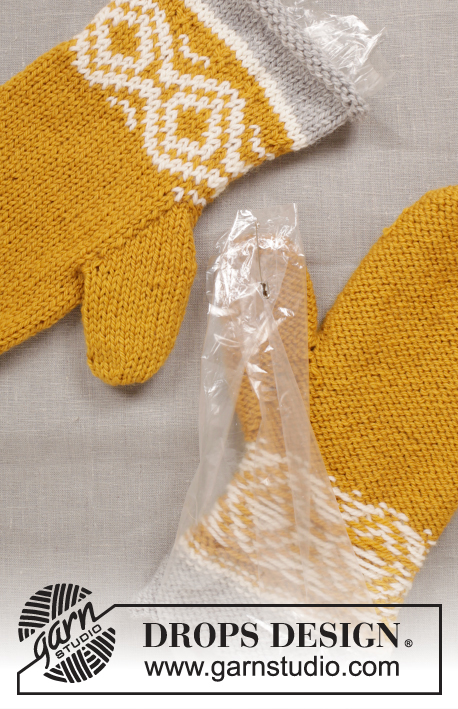 |
|||||||||
DROPS Easter: Knitted and felted DROPS mittens for men and women with Nordic pattern in ”Alaska”.
DROPS Extra 0-1245 |
||||||||||
|
PATTERN: See diagram A.1 (choose diagram for correct size: 22-22-24 (24-24 sts)). Pattern is worked in stocking st. INCREASE TIP: Inc 1 st by working 2 sts in the same st. ---------------------------------------------------------- MITTEN: Work piece in the round on double pointed needles with Alaska. Cast on 52-52-56 (56-56) sts on double pointed needles size 5.5 mm with light grey. Work entire mitten in stocking st - REMEMBER KNITTING TENSION. When piece measures 5-6-7 (7-8) cm, work PATTERN - see explanation above, in the round according to A.1 - AT THE SAME TIME dec 8 sts evenly on 5th row in diagram (dec by K 2 tog) = 44-44-48 (48-48) sts. When diagram has been worked vertically, continue with mustard until finished measurements - AT THE SAME TIME on first round dec 6-6-8 (8-6) sts evenly = 38-38-40 (40-42) sts. When piece measures 15-16-17 (17-18) cm, insert 1 marker in the 19th-19th-20th (20th-21st) st on round (= marking for thumb). Then inc 1 st on each side of st with marker, repeat in on outside of the inc sts every other round 3-3-4 (4-4) more times - READ INCREASE TIP = 46-46-50 (50-52) sts. After last inc, slip the inc sts + st with marker + 1 st in each side of these sts on a stitch holder for thumb = 11-11-13 (13-13) thumb sts. Cast on 3 new sts behind the thumb sts = 38-38-40 (40-42) sts. Piece measures approx. 21-23-25 (25-26) cm. Continue in stocking st in the round over these sts. When piece measures 36-38-42 (42-44) cm, work all sts tog 2 by 2 = 19-19-20 (20-21) sts. When piece measures 38-40-44 (44-46) cm, work all sts tog 2 by 2 one more time (when no of sts do not fit work last st K) = 10-10-10 (10-11) sts remain on needle. Cut the yarn and pull it through the remaining sts, tighten tog and fasten. THUMB: Slip the 11-11-13 (13-13) thumb sts on to double pointed needles size 5.5 mm and pick up 5 sts in the 3 inc sts from hand = 16-16-18 (18-18) sts. Work in the round on double pointed needles in stocking st. When thumb measures approx. 6-6-6½ (6½-7) cm from sts picked up, dec 4-4-6 (6-6) sts evenly (dec by K 2 tog) = 12 sts. Work 2 rounds. On next round, dec 4 sts evenly = 8 sts. When piece measures 8½-8½-9 (9-9½) cm, work all sts tog 2 by 2 = 4 sts. Cut the yarn and pull it through the remaining sts, tighten tog and fasten. Knit another mitten the same way. FELTING: Turn the mitten inside-out and place a plastic bag inside the thumb to avoid it felting together. Fasten it with a safety pin - NOTE: Fasten the pin vertically down towards tip of thumb to make it easy to remove after felting. Turn the mitten out again so that it is felted with RS outwards. Then place the mittens in the washing machine with a detergent without enzymes and optical bleach. Wash at 40 degrees with normal spin but no pre-wash. After wash shape the mittens to the right measurements while still wet and leave to dry flat. At subsequent wash, wash the mittens at regular wool programme. AFTER FELTING: If the piece is not felted enough and is too big: Wash the piece one more time in the washing machine while it is still wet add a terry towel that measures approx. 50 x 70 cm - NOTE: Do not use a short program. If the piece has been felted too much and is too small: While the piece is still wet stretch it to the correct measurements, if the piece is dry, make sure to soak it first. Remember: All subsequent washes are as a normal wool garment. |
||||||||||
Diagram explanations |
||||||||||
|
||||||||||
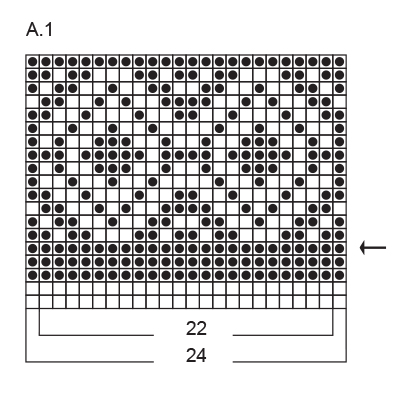
|
||||||||||
Have you finished this pattern?Tag your pictures with #dropspattern #touchofgoldmittens or submit them to the #dropsfan gallery. Do you need help with this pattern?You'll find 19 tutorial videos, a Comments/Questions area and more by visiting the pattern on garnstudio.com. © 1982-2025 DROPS Design A/S. We reserve all rights. This document, including all its sub-sections, has copyrights. Read more about what you can do with our patterns at the bottom of each pattern on our site. |
||||||||||







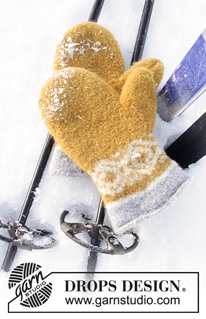
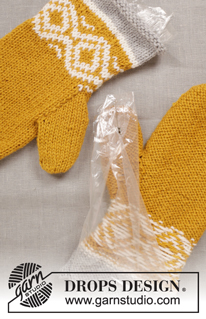
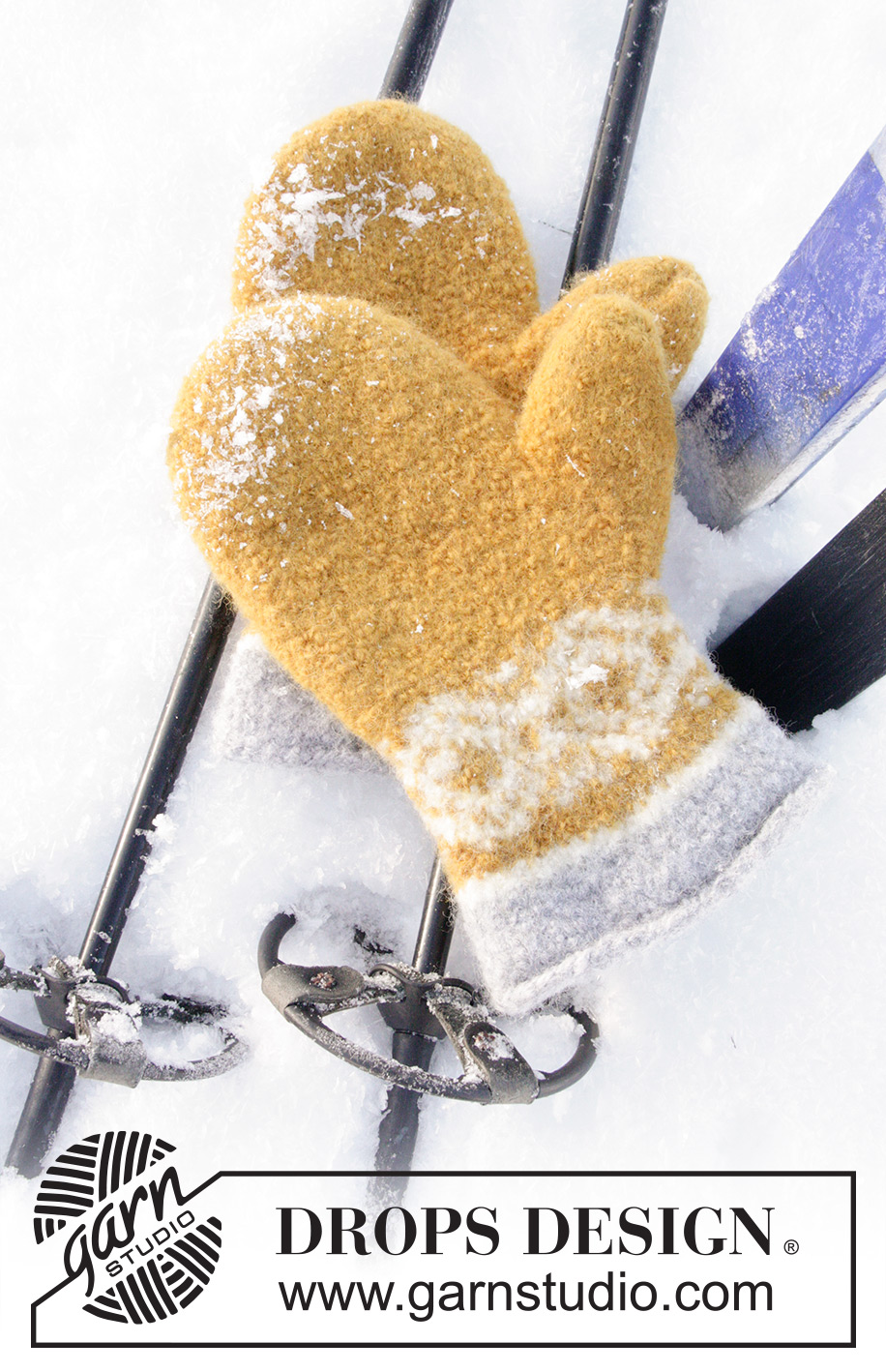
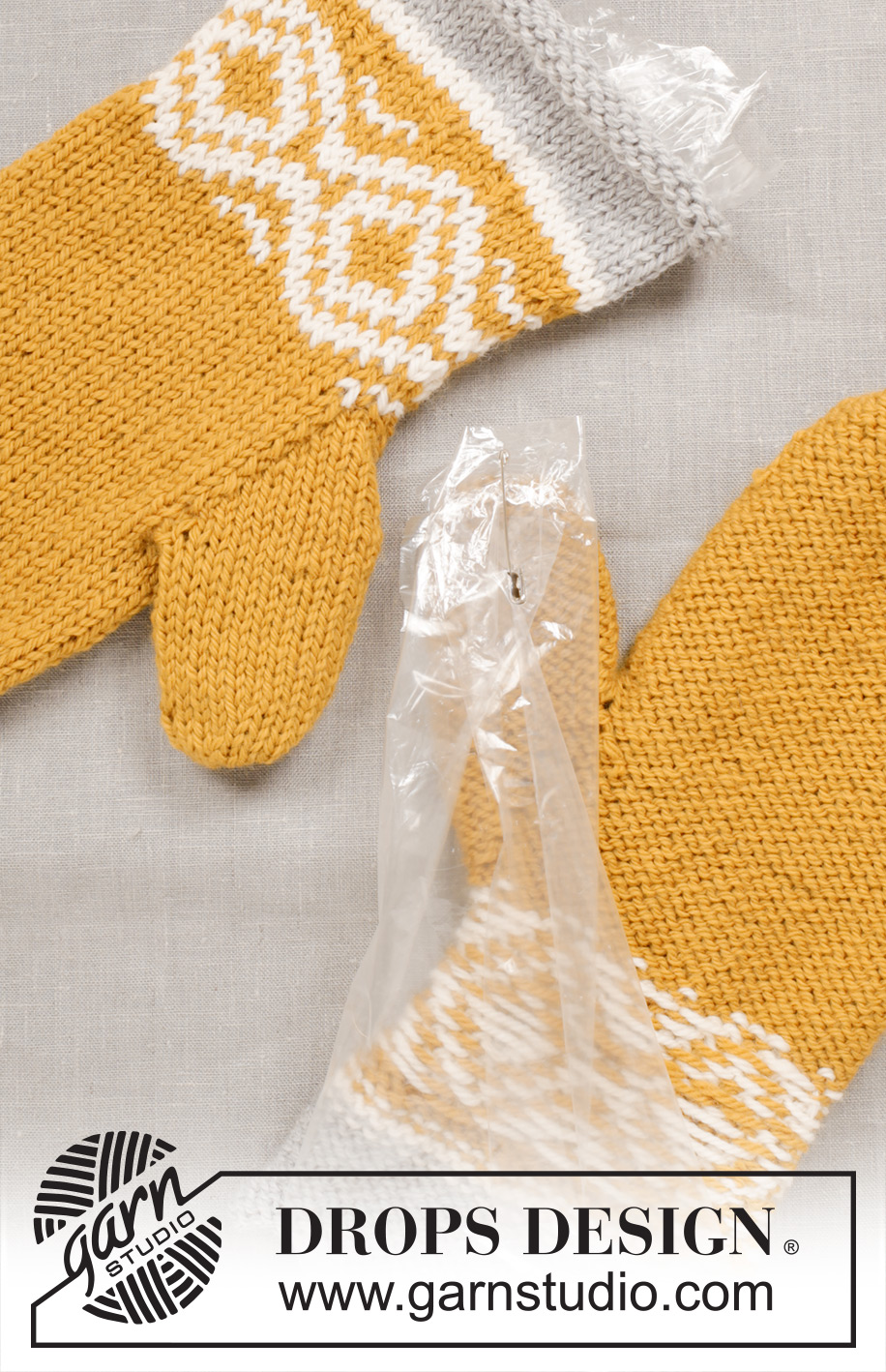


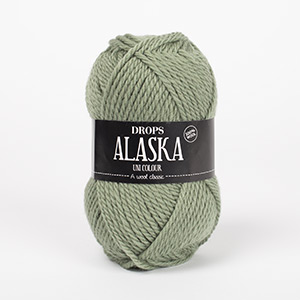


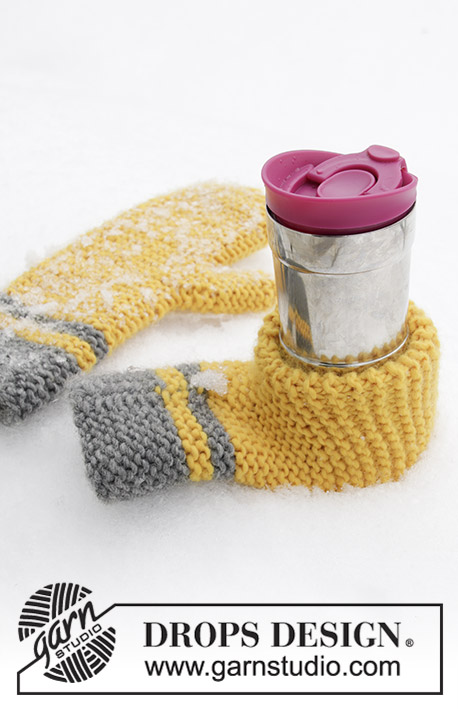






















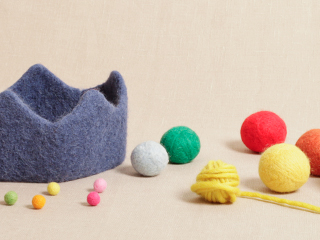















Post a comment to pattern DROPS Extra 0-1245
We would love to hear what you have to say about this pattern!
If you want to leave a question, please make sure you select the correct category in the form below, to speed up the answering process. Required fields are marked *.